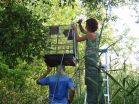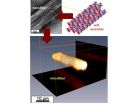Over 23,000 children aged 5-16 years were studied in nine countries (England, Australia, USA, Norway, Denmark, Estonia, Switzerland, Brazil and Madeira, Portugal). The researchers examined associations between the time of sunset and physical activity levels, measured via waist-worn accelerometers (electronic devices that measure body movement).
Published in the open access journal International Journal of Behavioural Nutrition and Physical Activity, the study found that children's total daily activity levels were 15-20% higher on summer days with sunset after 21:00, compared to winter days with sunset before 17:00. This was particularly the case in the European and Australian populations, and was observed even after the researchers adjusted for weather conditions and temperature.
First author Dr. Anna Goodman, Lecturer at the London School of Hygiene & Tropical Medicine, said: "This study provides the strongest evidence to date that, in Europe and Australia, evening daylight plays a role in increasing physical activity in the late afternoon and early evening – the 'critical hours' for children's outdoor play. Introducing additional daylight savings measures would affect each and every child in the country, every day of the year, giving it a far greater reach than most other potential policy initiatives to improve public health."
This research is relevant to ongoing political discussions on proposals to shift the clocks forward by an additional hour year round. A Bill on additional daylight saving measures was debated in British Parliament between 2010 and 2012, with proposals which would have seen British children having an estimated 200 extra waking daylight hours per year. Several Australian states have also held repeated referenda on the topic, with the issue spawning the creation of the single-issue political party 'Daylight Saving for South East Queensland' in 2008.
The researchers estimate that the proposed additional daylight savings measures would lead to an average of two extra minutes of moderate-to-vigorous physical activity per child per day. With children spending an average of 33 minutes a day on this type of activity, the researchers say that an additional two minutes is modest but not trivial in relation to children's overall activity levels.
These effects also appeared to be broadly equitable, applying to girls as well as to boys; to overweight/obese children as well as to normal weight children; and to children from different socio-economic backgrounds.
Importantly, the study provides the best evidence to date that longer evening daylight plays a causal role in increasing physical activity. The first piece of evidence was that the timing of sunset corresponded to a sharp drop in physical activity levels. For example, when the sun set between 18:00 and 19:00 then those were also the hours during which physical activity fell fastest.
The second piece of evidence involved using countries' bi-annual changing of the clocks as a 'natural experiment'. By studying the activity of 439 individual children measured on the days just before and just after the clocks changed, the researchers showed that the same child immediately became more active on the days where the sunset had been moved an hour later.
The authors conclude that the introduction of additional daylight saving measures in Europe and Australia could yield worthwhile public health benefits1. Senior author Ashley Cooper, Professor of Physical Activity and Public Health at the University of Bristol, concludes "While the introduction of further daylight savings measures certainly wouldn't solve the problem of low physical activity, we believe they are a step in the right direction."
INFORMATION:
The study was funded by the UK National Prevention Research Initiative, and Anna Goodman's contribution was funded by the National Institute for Health Research.
To request a copy of the paper or to interview the authors, please contact the London School of Hygiene & Tropical Medicine press office on press@lshtm.ac.uk or +44(0)207 927 2802.
Notes to editors
1. There was little or no consistent evidence of associations with evening daylight in the samples from America, Brazil or Madeira. Almost all of the study populations also came from high-income settings, meaning that more research would be needed to establish how far the observed associations apply across other settings.
2. Paper reference: Anna Goodman, Angie S Page and Ashley R Cooper. Daylight saving time as a potential public health intervention: an observational study of evening daylight and objectively-measured physical activity among 23,000 children from 9 countries. International Journal of Behavioral Nutrition and Physical Activity 2014, 11:84
3. If you wish to provide a link to this paper for your readers, please use the following, which will go live at the time the embargo lifts: http://www.ijbnpa.org/content/11/1/84
4. About the London School of Hygiene & Tropical Medicine
The London School of Hygiene & Tropical Medicine is a world-leading centre for research and postgraduate education in public and global health, with 3,900 students and more than 1,000 staff working in over 100 countries. The School is one of the highest-rated research institutions in the UK, and was recently cited as the world's leading research-focused graduate school. Our mission is to improve health and health equity in the UK and worldwide; working in partnership to achieve excellence in public and global health research, education and translation of knowledge into policy and practice.
5. About the National Institute for Health Research
The National Institute for Health Research (NIHR) is funded by the Department of Health to improve the health and wealth of the nation through research. Since its establishment in April 2006, the NIHR has transformed research in the NHS. It has increased the volume of applied health research for the benefit of patients and the public, driven faster translation of basic science discoveries into tangible benefits for patients and the economy, and developed and supported the people who conduct and contribute to applied health research. The NIHR plays a key role in the Government's strategy for economic growth, attracting investment by the life-sciences industries through its world-class infrastructure for health research. Together, the NIHR people, programmes, centres of excellence and systems represent the most integrated health research system in the world. For further information, visit the NIHR website (http://www.nihr.ac.uk).





